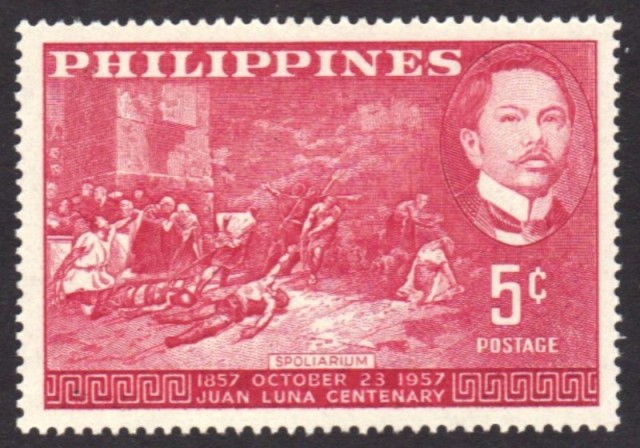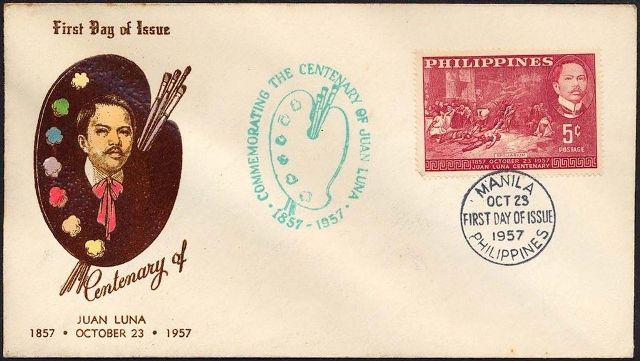1957, October 23. Juan Luna Birth Centennial
Engraved, Thomas dela Rue, Perf 14 x 14 1/4
Singles, Sheets of 50

5c Spolarium - Singles (2,000,000)
First Day Covers: Manila
Juan Luna - Birth Centenary
Juan Luna is considered one of the greatest Filipino artists in Philippine history with masterpieces such as Spolarium, The Death of Cleopatra and Blood Compact. Not only did he excel in artistry, but he was also a political activist during the time of the Philippine Revolution during the late 19thcentury. His close friendship with National Hero Jose Rizal has sparked Philippine nationalism and pride. Juan Luna was mostly known for his works as being dramatic and dynamic, focusing on romanticism and realism styles of art.
Born on October 23, 1857 in the town of Badoc in Ilocos Norte, Juan was the son of Don Joaquin Luna de San Pedro y Posadas and Doña Laureana Novicio y Ancheta. Juan’s early interest in art was due to the influence of his brother, Manuel, who was also a painter. He received his degree in Bachelor of Arts at Ateneo de Manila and enrolled later at Escuela Nautica de Manila where he became a sailor. This did not stop Luna from his pursuit in developing his artistic skills. He took lessons under the famous painting teacher Lorenzo Guerrero and also enrolled at Academia de Dibujo y Pintura under the Spanish artist Agustin Saez.
In 1877, Juan Luna traveled to Europe to continue his studies and enrolled at Escuela de Bellas Artes de San Fernando. It was in 1881 when he received his first major achievement as an artist and this is through winning a silver medal at the Exposición Nacional de Bellas Artes (National Demonstration of Fine Arts) with his work The Death of Cleopatra. From there, he continued to gain recognition and respect as an artist. Juan Luna kept on impressing the European and Filipino society through the Exposición Nacional de Bellas Artes with outstanding works such as the Spolarium which won gold in 1884 and Battle at Lepanto in 1887.
Juan Luna’s other popular works include The Happy Beauty and the Blind Slave, Tampuhan, Mestiza Lady at her Dresser and Roman Ladies. He died in 1899 at the age of 42 after he suffered from a heart attack. Today, several of his works can be found in esteemed museums in the Philippines such as the Lopez Museum and National Museum.
-
Art / Paintings
